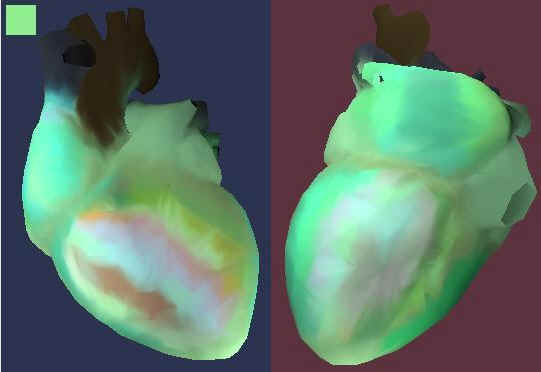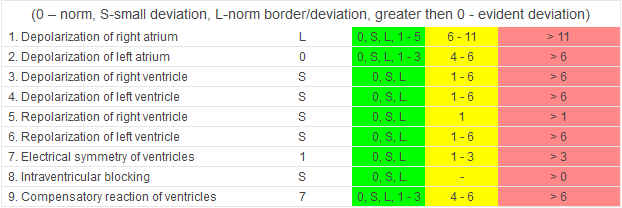Right after examination, the system Kardi.Ru automatically analyzes the data which it receives at survey, and returns you the report which contains:
The first thing you need to pay attention immediately after the examination - it is a visual heart portrait.

The right chambers of the heart (right atrium, right ventricle) are represented on the blue background of the heart portrait. Left atrium and left ventricle below are presented at the top on a brown background.
All cameras on a heart portrait are green in normal state. If there are some small deviations, the details of the portrait are marked in yellow. And the expressed deviations are in red.
Estimate of the indicators "Myocardium", "Rhythm" and "Pulse" is the next step in the analysis.

Indexes "Myocardium" and "Rhythm" are relative characteristics that characterize the total value of the deviations dispersion from the norm and changed in the range 0% ... 100%. The more value of index - the is more deviation from the norm. Physically, the meaning of "infarction" = 100% corresponds to the pathological complex that is associated with significant deviations from the norm practically in all chambers of the heart. Value "Myocardium" = 0% corresponds to complete absence of any significant deviations from the dispersion model of the ideal heart. Similarly, the rate of "Rhythm" = 100% corresponds to the most expressed changes in the regulation of heart rhythm peculiar to expressed arrhythmias or strong stress.
"Myocardium" - it is the main index to which you should pay attention!
less than 15% – no significant deviations.
15% ... 19% – it is borderline state, control of dynamic is expedient. At negative dynamics, i.e. at slow rise of value of the indicator, mandatory consultation of the doctor is necessary. The borderline state can result from weariness because of a physical or mental overload, an irrational delivery, alcohol influence, and also the metabolic changes caused by pathology of other organs. Therefore, the sustainable preservation of this state requires consult a doctor. If the borderline state due to transitory factors, the indicator should decrease gradually, reflecting the functional normalization myocardium.
20% ... 22% – pathology is probable. If this deviation is detected for the first time - need to control the dynamics (increased frequency of surveys) and medical examination is expedient. If the indicator steady rise in this range - a medical examination is necessary.
23% ... 27% – pathology is probable. If this deviation is detected for the first time - control of dynamics and mandatory examinations are necessary.
более 27% – pathology or the expressed pathology. If this deviation is detected for the first time, steadily repeated and has no tendency to increase in successive examinations - should be examined at the first opportunity. If in this same situation has steadily rapid growth of the deviations of time measured by minutes or other minute intervals – the emergency consultation of the doctor is necessary.
Index"Rhythm" is a marker of the adaptive capacity of the organism, or arrhythmia:
less then15% – no significant deviations.
15%...50% - slight deviations (may be a variant of the norm in the natural daily oscillations).
51%...80% - it is borderline state.
more than 80% - expressed deviation from the norm. This is a sign of exhaustion of compensatory allowance (asthenia) in the regulatory system of the heart rhythm. Medical examination is necessary.
The indicator "Pulse" given for information only, since it is important for the doctor in case of need medical consultation at the cardiologist.
These indicators are not mandatory at the analysis. They are intended for the doctor mainly if medical consultation is required. The user according to "User's guide" can view some of these indexes only by control of dynamics of heart state.
Additional indicators are displayed in the form of 9 indicators G1,G2,G3,G4,G5,G6,G7,G8.G9.

Indexes G1, G2 characterize atrial myocardium. Increased attention to these indexes may be appropriate in the presence of arrhythmias, or pronounced changes in the index of electrical instability. Indexes G5, G6 concern ventricles. These indexes increase with significant pathological changes practically always. However, there may be transient changes caused by, for example, dehydration, high salt intake in the diet, etc. factors. Index G8 gives a rough estimate of average excitation rate of the ventricles, and also is intended for the doctor. If index G9 steadily increased also matters 7 and more –to consult the cardiologist is expediently. In many cases it can be a forerunner of developing or already available hypertrophy of one of ventricles. Though in younger age groups, for example at children, it can be a natural physiological background which is caused by growth processes. Similarly, if the symmetry indices of ventricular G7 and G3 + G4 steadily increased are a sign of possible pathological changes.
Right after examination to you is formed "the General conclusion", which contains value of main index "Myocardium" and text recommendation in which it will be specified "variant of norm" or the recommendation "address to the doctor". If the system detects the expressed deviation, there will be recommendation "address to the doctor immediately". The additional information which has interest for the doctor is displayed preferentially in the following sections of "Rhythm," "Atriums," etc.

All your examinations are stored in the system, therefore you can trace dynamics of heart state changes easily. At presence of the expressed deviations to monitor the dynamics of indicators change is the most important. To address to the doctor follows at evident augmentation of indicators immediately. Such reference is formed for the user in "General conclusion" and marked in red color usually.
You can look at examples of the real conclusions in demo private site area which is open for all visitors of site.
The instruction in which explained in detail about operation with Cardiovisor for home, can be found here.